“Women Rebelling” is a series of six paintings by Kirkland-based artist Houri Ronasi.
Right now, you can find them hanging on the walls of the Hillman City Collaboratory, but I’ll describe them to you:
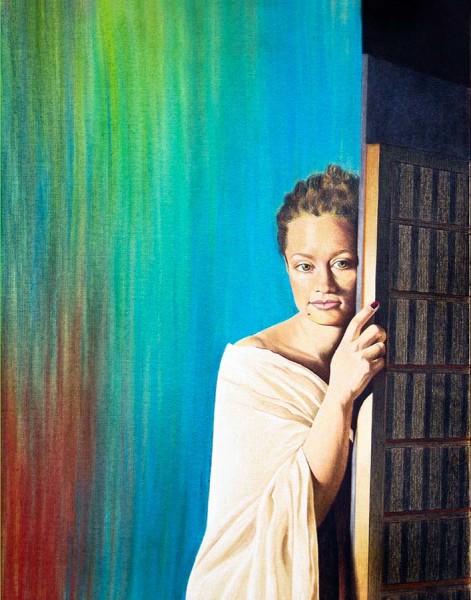
The first painting is a close up of a woman’s face and upper body, in a realist and classical style. The woman’s curly, light brown hair is tied back, and her body is modestly draped by a large white fabric. She presses herself against a door. The effect is one of serenity, deep reflection and oneness with the self.
Ronasi lived through the Iranian Revolution of 1979. Prior to the Revolution, she had moved to Tehran to study art and lived alone, something that would be difficult for a woman to do in today’s Iran. However, universities were closed for months during the uprising and Ronasi immigrated to the U.S. in frustration to continue her studies.
Just one week later, the Iran hostage crisis occurred and everything changed. Iran went from having strong ties to the United States to the U.S. instituting economic sanctions against Iran.
“The money was cut. My parents couldn’t send me any money. I was studying, but not art anymore, because I had to make money right away.”
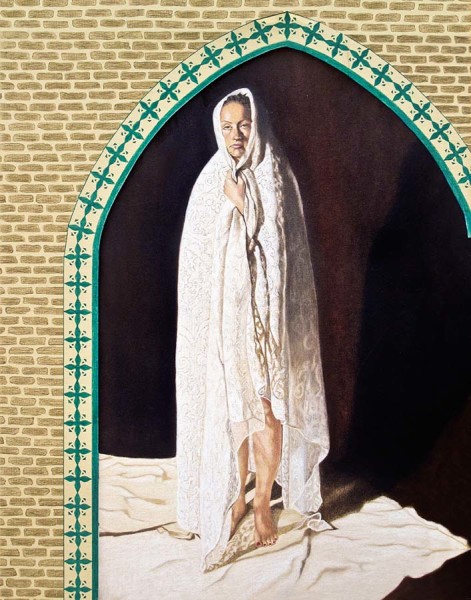
The second painting shows the same woman with the sheet wrapped over her head, covering her hair and falling to her feet. Unlike the first painting, she stares off into the distance rather than meeting the gaze of the viewer, and her expression is downtrodden. Most tellingly, pressed on top of the painted image is an outline of an arched minaret associated with Islamic architecture, and a wall of bricks.
And yet, in this second image, the woman is engaged in quiet acts of rebelling. Her shins are exposed and her toenails are painted crimson, an act which can be considered immoral and worthy of punishment in modern day Iran.
After moving to the U.S., Ronasi spent several years in the corporate world, her creative life largely on the backburner, until she was diagnosed with cancer. The diagnosis was a wake up call to her to follow her dreams and return to her art.
“It took 36 years for me to become what I was intended to be… I had cancer and that’s when I was able to do my art,” she says. “I always look at the positive side. This cancer… was god’s break to me, to be able to create.”
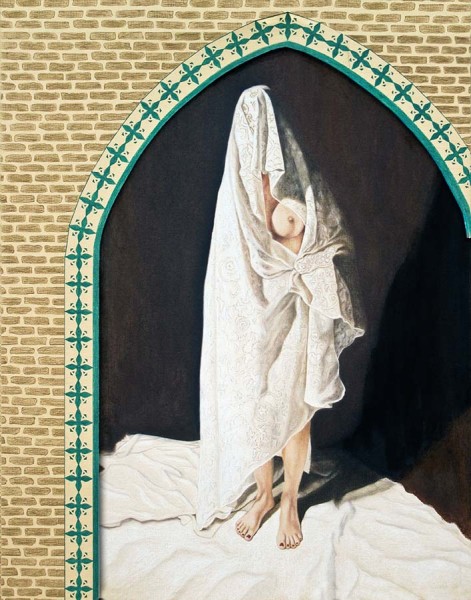
The series continues with these moments of resistance: painting three shows the woman with her face covered inside the mosque but one breast exposed. The painting evokes the current conversations around public breastfeeding in the U.S. — it is difficult to sexualize this lone exposed body part.
Ronasi acknowledges that the hijab is a symbol of oppression based on sex and gender, and not oppressive in its own right. She emphasizes the importance of choice. In pre-Revolution Iran, Mohammed Reza Pahlavi Shah, known popularly just as the Shah, opened up Iran to development by American capitalists. He also banned the wearing of the hijab in Iran.
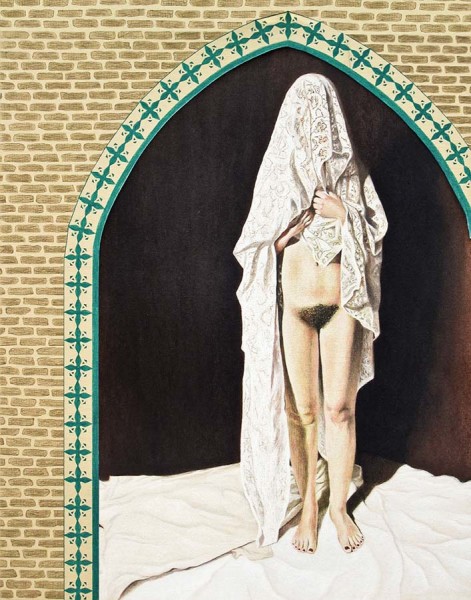
The fourth painting shows the woman with her head and upper torso covered but her body below the waist completely exposed. Her arms are still held tightly to her chest, as she has been using her hands to keep the chador or veil on her body.
When Ayatollah Khomeini came to power, after a revolutionary movement that promised Iranian women a key spot at the table, the hijab was enforced upon all.
“There were promises that the country would be more liberal, there would be more freedom, but none of that was real,” Ronasi says. “It was just a way for the revolutionaries to get to power.”
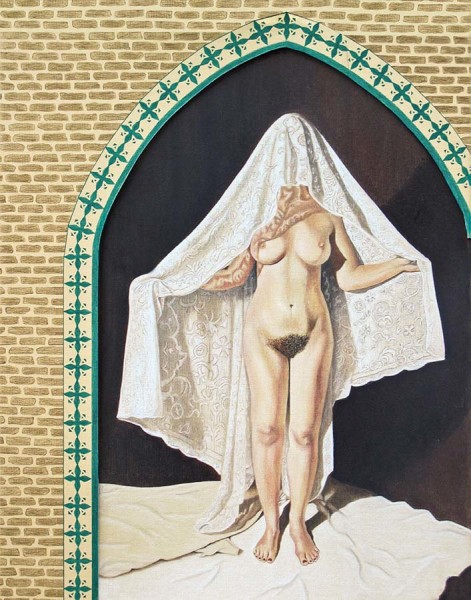
In the fifth painting in the series, the woman holds her arms open, revealing everything but her head and face.
In a visit to her studio in Kirkland, it’s apparent that many of Ronasi’s other pieces address her experiences with illness and breaking out of the persona that a corporate career forced her to take on. “Women Rebelling” is just as emotionally captivating and yet, reflects another aspect of the human experience.
“It is the voice of all of us women. It’s not just me, ” says Ronasi about the series. “I didn’t go through the period that’s going on right now in my country. But I cannot separate myself from my countrywomen or, for that matter, from all of the women in the world. For all of the human beings who have suffered.”
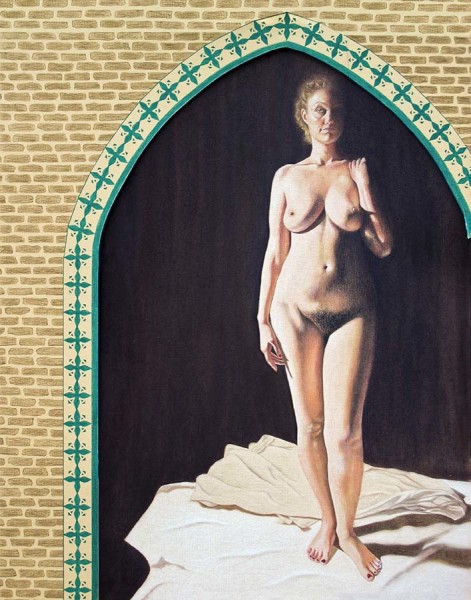
In the final painting, the woman stands completely exposed, the chador dropped behind her, one hand at her side, the other on her shoulder. Half of her face is in the shadows. Her right eyebrow is slightly raised and her lips are pursed, as if she has had enough and is, in her quiet way, challenging the viewer to comment.
At a time when Islamophobia is on the rise in the United States, and yet women here, in Iran and all over the world are struggling with the right to make choices about their bodies, “Women Rebelling” is a strong statement on the universality of the human experience.
“I wish I was a poet, I was a writer, so I could speak it but my weapon is my work, my art,” Ronasi says. “When I go to exhibitions or sell a piece, it’s not that I want to make any money, it is the fact that this is my pen. And I want to put the images of my inner pain for the world on the canvas so people would see. I would love to bring a moment of consciousness. Just a moment.”
Houri Ronasi’s “Women Rebelling” is currently on exhibit at the Hillman City Collaboratory at 5623 Rainier Avenue South in Seattle. The exhibit will also be part of the Kirkland Artist Studio tour on May 7 through May 8.
Ronasi’s new work will also be exhibited in April at Ryan James Gallery and in May at the Kirkland Art Center Gallery’s artist’s exhibition.
Learn more about the artist at www.hourironasi.com.


Houri Ronasi’s series of paintings, “Women Rebelling,” will be on display at the Hillman City Collaboratory (5623 Rainier Ave S., Seattle) through March 2016. As the co-curator of the exhibition, I’m proud to include important work like “Women Rebelling.” For more information, please visit the artist’s website, hourironasi.com, or the website of Seattle Realist Artists, seattlerealistartists.com.